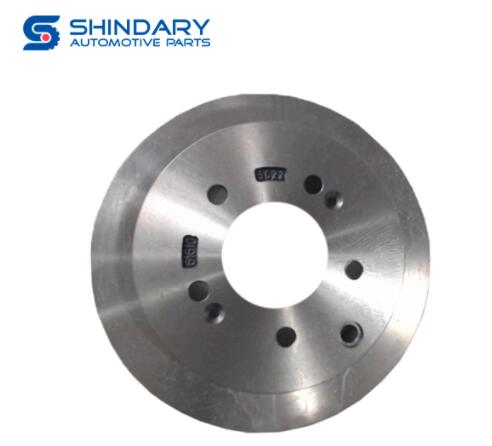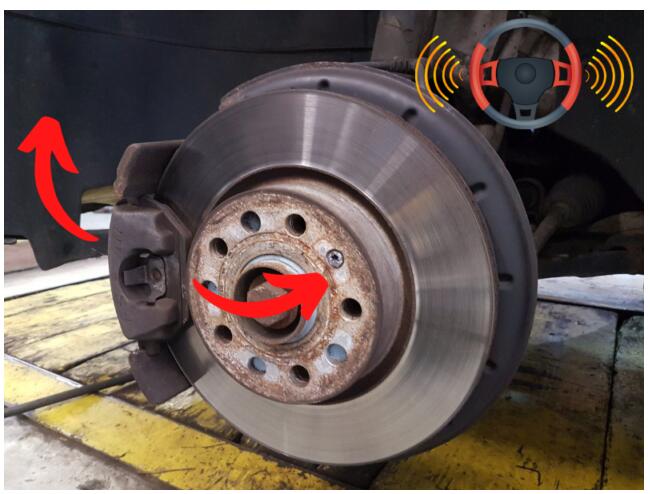Copyright © Shindary Automotive Parts Co., Ltd. All Rights Reserved
The most common cause of steering wheel shaking when braking is because one or both front brake discs warp, causing the caliper to wobble when the brakes are applied. The brake discs may be warped due to poor quality, drastic temperature changes or wear.
When you apply the brakes, the calipers apply pressure to the surface of the discs and your car starts to brake. The surface of the brake disc should be flat so that the caliper applies constant and equal pressure. If your brake rotor is warped for some reason, the caliper will start to wobble and your steering wheel will start to wobble when you start braking.
Brake rotors can warp for a number of reasons. A good quality brake rotor can withstand temperatures up to 200 degrees Celsius or 392 degrees Fahrenheit. Imagine driving around town and constantly applying the brakes.
The temperature of the brake rotors will rise with each brake application. Then, you may decide to take your car to the car wash or it starts to rain. At this point, you have a heated brake rotor in contact with cold water. The drastic temperature change can cause your brake rotors to warp.
Warped brake rotors should always be replaced with new discs. You can grind the brake rotor and fix the warpage. However, I recommend that you take this more seriously and replace your warped brake discs with new ones. You should not save money when fixing serious car problems such as brakes.

Driving around with a bent brake rotor can cause your steering wheel to wobble under braking. This can be both an unpleasant experience and a safety issue. So, what causes brake rotors to warp? Here are some answers for you.
1. Overheating problem
Every time you use your brakes, the temperature of your brake discs rises. Sometimes, during brake application, the caliper piston can seize and possibly "burn up" the brake rotor. This is what we call an overheating problem.
Other problems that can cause brake discs to overheat are brake pads sticking to the bracket. When this happens, there will be a burn-like mark on the brake disc. That will be a raised area, especially if the rotor is getting hot from driving and can cause brake pulsation.
To verify that your brake rotor is not warped due to an overheating problem, you must perform a visual inspection. Remove the wheel and carefully inspect the brake rotor. If you see areas on the brake rotor that look like straight lines of hot spots, then these lines will be increasing.
So, when you apply the brakes, the caliper will apply pressure to the disc and you will feel the brakes pulsating as it crosses the accumulation line. At this point, your brake system has an overheating problem that must be properly addressed.
2. Rust pits on the brake discs
If your vehicle has been parked for a long time, your brake discs can and will accumulate rust on them. Rust on brake discs can lead to uneven surfaces and warping of the discs.
If you see small pits on your brake discs, they are actually rust pits. What happens is that when your vehicle sits for an extended period of time, it builds up moisture on the entire brake surface.
Since the moisture stays there for a while, it gets into the porous material of the rotor, since brake rotors are made of metal. Rust starts to form these little pits. Then, once you drive it, it removes the outer part of the rust and it leaves all these pits behind, causing the surface to be uneven. Rusty brake rotors can definitely cause brake pulsation, steering wheel shake, and even noise.
3. Damaged surfaces with metal-to-metal contact
If the caliper piston is stuck in the braking position, it will apply constant pressure to the brake pads against the disc and damage the disc surface. The way braking works is that when you depress the brake pedal, brake fluid flows over the brake piston, causing it to squeeze the brake pads against the brake rotor. If the piston is stuck in this position, it will keep pushing the brake pads into the brake rotor and will damage the surface of the rotor.
The caliper piston needs to squeeze the brake pads when you depress the brake pedal and then retract when you release the brake pedal. You can perform a visual inspection to see if your brake pistons are working properly. Also, you can drive your vehicle as slowly as possible and if you hear a rubbing sound, you should check your brake system.
4. Wear and tear
If used for too long, the brake rotors may become deformed. The service life of brake rotors depends on the size, driving style and quality of your vehicle? Generally speaking, most brake rotors have a life expectancy of between 50,000 and 70,000 miles.
If your vehicle is parked for too long, or if you drive it for too long without replacing the brake rotors, they may warp. As I said before, bent discs can cause your steering wheel to wobble under braking.
It is best to replace your discs every 50,000 to 70,000 miles. However, I recommend checking the thickness of the brake rotors before replacing them. Depending on your driving style, brake rotors can last even longer than expected.
5. Drastic Temperature Changes
Every time you use your brakes, the brake rotors add heat. Typically, most brake rotors can withstand temperatures of up to 209 degrees Celsius or 408 degrees Fahrenheit. So imagine you're driving around town and you're constantly applying the brakes. Typically, the brake rotors get hot.
Then, you take your vehicle to the car wash. Now, you are cleaning the heated brake rotors with cold water. Washing heated brake rotors with cold water causes thermal shock and over time, the discs will warp.

Measuring the minimum thickness of the front and rear brake discs will show you if your discs are warped. Front brake discs with uneven surfaces can cause the steering wheel to shake when we brake. Rear brake discs will only cause pulsation in the brake pedal if they are warped. Here's how to measure the thickness of a brake rotor and check it for warpage.
1. Collect the materials needed to measure the brake rotor
You need to use the right tools to measure the thickness of the brake rotor and check it for warpage. Therefore, before starting this process, make sure you have collected the required materials.
✱ Safety gloves. I always prefer to wear safety gloves when working on my car, as many corrosive fluids can cause skin damage.
✱ Goggles. Since I accidentally splashed motor oil in my eyes, I started wearing goggles when working around cars. Please don't wait for an accident to happen and get yourself some safety goggles.
✱ Car jack. You will need to lift the vehicle to check the thickness of the brake discs.
✱ Brake rotor gauges. Brake rotor thickness measurement is done by specially designed gauges
✱ One-way wrench. This telescopic lug wrench with 17mm and 19mm sockets is perfect for this job.
2. Lift the vehicle
In order to check if your brake rotor is warped, you need to access the brake rotor by removing the wheel. Park your vehicle on a level surface and secure the wheel with a brick or block of wood. Then, jack up your vehicle and place it on jack stands. To learn the jacking points for your vehicle, read the owner's manual.
3. Remove the wheels
Remove the wheels by removing the lug nuts. Lug nut sizes may vary, but in most cases you will need a 17mm or 19mm drive and 1/2 ratchet for better leverage.
At this point, one side of your vehicle is lifted. Be careful when removing the lug nut with force, as it may start to wobble. Store the lug nuts and wheels safely as you will reinstall them later.
4. Remove the caliper
With the wheels off, remove the caliper by removing the two bolts located on the back. Then, use the straps to securely attach the caliper to the spindle to hold the caliper in a safe position where we will not put pressure on the hose. Do not allow the caliper to hang from the hose as this will damage the hose.
5. Use the measuring tool to measure the brake rotor
Before starting the procedure, zero the brake rotor measuring tool. Place a micrometer on the brake rotor and measure in multiple positions. If the brake rotor measures differently in different positions, then it is safe to say that your brake rotor is deformed and needs to be replaced.
The minimum thickness of the front brake rotor is 19 mm and the rear brake rotor is 8 mm. Any front brake rotor less than 19 mm or rear brake rotor less than 8 mm is considered to be below specification.
6. Reinstall the parts
After measuring the thickness of the brake discs, reinstall the calipers and wheels. If your brake discs are below the minimum thickness, I recommend that you replace the old discs with new ones. Also, while you are using it, you can check the brake pads.
Previous: SPARE PARTS NUMBERS FOR CHERY TIGGO2
Shindary Automotive Parts Co., Ltd.